Identity Texts
Mini-Series: Honoring and Leveraging Students’ Home Languages in the Classroom
This is the third blog in the mini-series “Honoring and Leveraging Students’ Home Languages in the Classroom.” In this post, I consider why it matters for students to encounter books that represent their lived experiences and introduce bi/multilingual identity texts as one method for creating self-affirming texts in the classroom.
Blog 3: Identity Texts
Many of the educators and scholars reading this blog are likely familiar with Dr. Rudine Sims Bishop’s metaphor of books as mirrors, windows, and sliding glass doors. Books are mirrors, she explains, when they reflect our identities and experiences, containing characters who look like us, talk like us, eat like us, celebrate like us, and dream like us. Books can also be windows into how others experience the world. And, sometimes, books can even serve as sliding glass doors, enabling us to step into the text and imagine the world from another’s perspective. Bishop argues that it is often the act of mirroring our lived experiences that gives books their deepest power. She explains:
Literature transforms human experience and reflects it back to us, and in that reflection we can see our own lives and experiences as part of the larger human experience. Reading, then, becomes a means of self-affirmation, and readers often seek their mirrors in books. (1990, p. ix)
For students like me from the dominant societal group—white, middle class, English-speaking—there is no shortage of books reflecting our identity and experiences. As a child, I recall being particularly enthralled by books with strong (white) female leads, series like The Baby-sitters Club and Nancy Drew, that enabled me to see myself in the characters and to imagine the person I might become. Cultural psychologist Michael Cole (1996) describes this imaginative projecting as “prolepsis”—a mediated, future-oriented representation of our present selves, the theorizing of our potential.
Unfortunately, for many students, finding books that serve as mirrors can be a difficult task. A recent review conducted by the Cooperative Children’s Book Center examining diversity in children’s books found that, of the 3,134 children’s books published in 2018, a full 50% of books featured characters who were white. Animals received the next largest representation (27%), with characters of color (African Americans, Asian Pacific Islanders, Latinx, American Indians, etc.) making up the bottom 23% combined. An infographic created by illustrator David Huyck visually represents this data, painting a stark picture of the absence of mirrors that non-white students encounter when they engage with texts (see Figure 1).
Figure 1. Diversity in Children’s Books (2018)
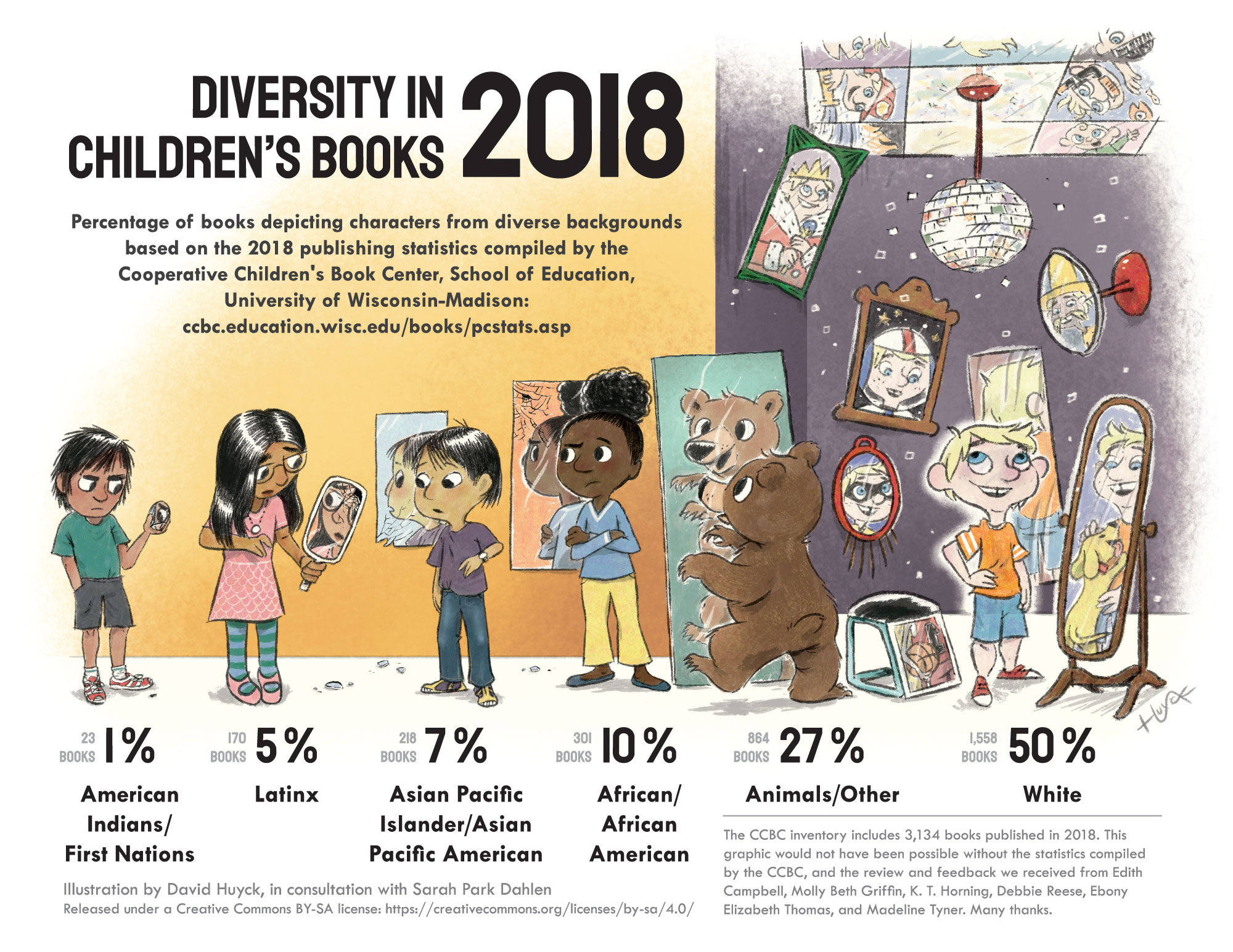
What can be done to remedy this lack of diversity in texts? While it is certainly important to continue advocating for more diverse books in our schools and libraries, there is another way that teachers can cultivate a more culturally and linguistically inclusive literary space in their classrooms: provide students with the opportunity to create self-affirming identity texts.
What are identity texts?
In the early 2000s, education scholar Jim Cummins coined the term “identity texts” to describe literacy projects that engaged minoritized students in composing multilingual texts that reflected their lived experiences and showcased their full linguistic repertoires. The concept of identity text is rooted in the understanding that literacy engagement leads to literacy achievement (Cummins & Early, 2011) and that schools and classrooms are power-laden spaces, containing roles and structures that often reflect inequitable power relations from the wider society. In response, identity texts seek to challenge oppressive power relations by reframing the exclusive use of the dominant societal language in classrooms and by cultivating self-affirming spaces for minoritized students.
One of the first identity text projects was the Dual Language Showcase (Chow & Cummins, 2003), a teacher-researcher collaboration at two diverse elementary schools near Toronto that explored how to design literacy activities that incorporated students’ home languages. The success of this project led to the proliferation of identity text projects in schools across Canada and around the world (see Cummins and Early’s [2011] book Identity Texts: The Collaborative Creation of Power in Multilingual Schools for case studies). In what follows, I provide some examples of identity texts from my work and that of Gail Prasad, an Assistant Professor at York University who first introduced me to identity texts. In our research and teaching, both Gail and I have explored the use of identity texts with students from minoritized and majority backgrounds, considering how the creation of these multilingual reflections of self can also serve as a means to foster “encounter” (Prasad, 2018) among students from different linguistic backgrounds and experiences.
Examples of identity texts
Prasad (2015) carried out identity text projects with elementary teachers in Toronto, Canada and Montpellier, France across five different schools, all of which instructed students in English and French and served a linguistically diverse student population. Across all school sites, Prasad found that identity text projects repositioned minoritized language learners as “plurilingual experts” and helped foster language awareness and an appreciation for linguistic diversity among all students. Some of the texts that students generated represented their individual identities, as in the example of Tolga, whose identity text included a short description of himself and was translated into four languages representative of his linguistic repertoire: French, Occitan, English, and Turkish (see Figure 2).
Figure 2. Tolga’s Identity Text (Prasad, 2015)
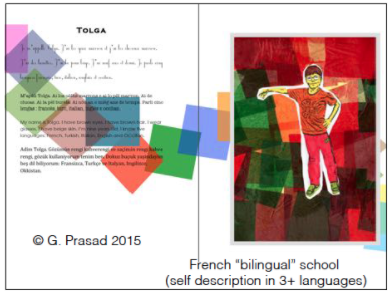
Other identity texts were generated in small groups or with the whole class, representing students’ collective linguistic identities and shared experiences. For example, students at one of the Canadian schools worked in small groups to create identity texts entitled Our Toronto, using the sensory prompts “My Toronto looks like… / sounds like… / smells like… / feels like… / tastes like…” to describe their experiences of the city. In each group, at least two of the students spoke a language other than French or English. After each student had individually drafted sensory sentences to describe Toronto, the group worked together to translate all of the sentences into the languages spoken collectively by the group (see Figure 3). Prasad found that the process of translating their descriptive sentences helped establish bonds among group members and fostered an appreciation of one another’s languages.
Figure 3. “Our Toronto” Identity Text
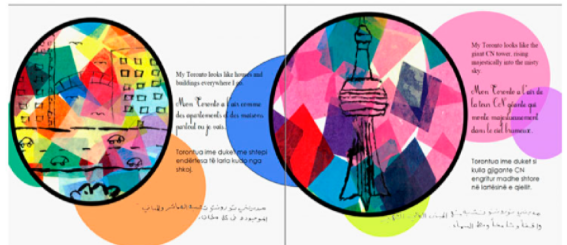
In my university classes, I have conducted this same identity text exercise with in-service and pre-service teachers and am always amazed by both the rich linguistic diversity of my students and the ways that such a simple activity helps students to encounter one another in new ways. For example, students in my ESL methods class at the University of Wisconsin worked in small groups to create digital books entitled “Our UW” using the same sensory prompts as in Prasad’s work with elementary students. One group wrote their text in English and Korean to describe the typical sights and sounds of the campus, from the blustery winter days to the energetic marching band. After students finished creating their books, I asked them to read the texts aloud—in all of their languages. After the text were presented, many students reflected that it was the first time they had ever heard peers speak their home languages, despite having known each other for years. And, students who spoke languages other than English commented that they felt “seen” in a new way through this activity.
Figure 4. “Our UW” Identity Text
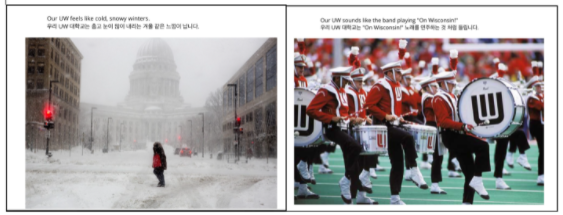
I also had the opportunity to work with Gail Prasad at a mainstream elementary school in Wisconsin, where we supported teachers in developing identity text projects in the content areas. Working closely with the kindergarten and first grade teachers, we brainstormed how the classes might create multilingual books that addressed grade-level science standards and represented students’ full linguistic identities. The first-grade teachers elected to create books about plants, with each class selecting a different focal plant (e.g., oak trees, pumpkins, sunflowers). Each class began the project by researching their plant and then, as a class, jointly constructed a text in English based on what they had learned. After the text was complete, copies were sent home to families so that parents could support the translation of the text into all of the languages spoken by students in the classroom. The resulting texts were a beautiful tribute to the linguistic diversity in the classroom, one that validated students’ linguistic identities and supported all students in learning more about plants and their life cycles (see Figure 5 for pages from All About Oak Trees; you can read more about the project here).
Figure 5. All About Oak Trees
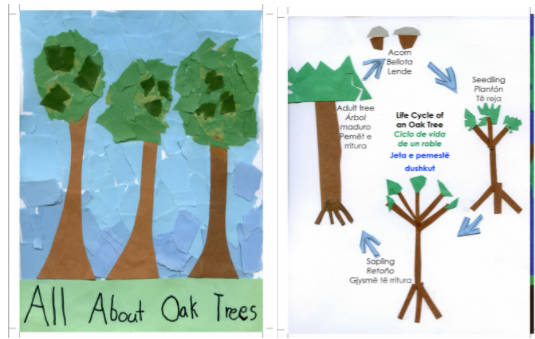
Closing thoughts
As I hope is evident from these examples, identity texts can be a meaningful way to validate minoritized language speakers by inviting students to engage in authorship to bring their home languages into the classroom. Additionally, identity texts can be a powerful tool for helping students to see one another in new ways, to begin to walk through the “sliding door” of difference and cultivate an appreciation for linguistic diversity—and with it, an appreciation for the diversity of language speakers. I invite teachers to consider how they might integrate an identity text project into their own classrooms, to engage students in becoming authors of their own experiences in ways that represent their full linguistic selves.
Additional Resources
- Authors in the Classroom: A Transformative Education Process by Alma Flor Ada and Isabel Campoy: This text an amazing resource for designing identity text projects. The book contains a range of prompts for poems and narratives to support students in becoming writers. You can also find examples of different types of identity texts (along with a range of other resources) on the authors’ website.
- https://www.iamplurilingual.com: This site was created by Dr. Gail Prasad to showcase identity texts created by students in her dissertation research. These are many excellent examples of identity texts that can serve as models for future student projects.
References
Chow, P., & Cummins, J. (2003). Valuing multilingual and multicultural approaches to learning. In S. R. Schecter and J. Cummins (Eds). Multilingual education in practice: Using diversity as a resource (pp. 32-61), Heinemann.
Cole, M. (1996). Cultural psychology. Belknap Press of Harvard University Press
Cummins, J. & Early, M. (Eds.) (2011). Identity texts: The collaborative creation of power in multilingual schools. Trentham Books.
Prasad, G. (2015). Beyond the mirror towards a plurilingual prism: Exploring the creation of plurilingual ‘identity texts’ in English and French classrooms in Toronto and Montpellier. Intercultural Education, 26(6), 497–514.
Prasad, G. (2018). Building students’ language awareness and literacy engagement through the creation of collaborative multilingual identity texts 2.0. In Language awareness in multilingual classrooms in Europe: From theory to practice. De Gruyter.
Prasad, G., & Lory, M. P. (2019). Linguistic and cultural collaboration in schools: Reconciling majority and minoritized language users. TESOL Quarterly, 0(0), 1–26.
Sims Bishop, R. (1990). Mirrors, windows, and sliding glass doors. Perspectives, 1(3), ix–xi.
Strohmeyer, B., & McGrail, L. (1988). On FOCUS: Photographs and writings by students. El Centro del Cardenal.
